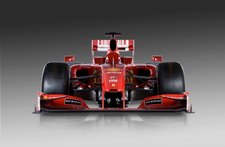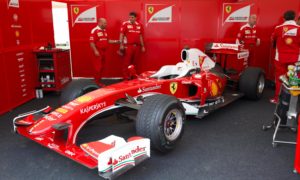 Ferrari were first to usher in a new era of Formula One today with the launch of their 2009 challenger, the F60, in Mugello. Forumula1.com’s Dan Barnes looks back on the highs and lows of 2008 and assesses the Scuderia’s chances of title glory one year on.
Ferrari were first to usher in a new era of Formula One today with the launch of their 2009 challenger, the F60, in Mugello. Forumula1.com’s Dan Barnes looks back on the highs and lows of 2008 and assesses the Scuderia’s chances of title glory one year on.
The Ferrari F2008 may have had superior pace, but a lack of reliability allied to fudged pit stops and erroneous decisions ultimately cost Ferrari the drivers’ title.
The F2008 s strengths lied in its raw race pace. The Ferrari was estimated to have the most powerful engine on the grid with an advantage over the midfield of around 25 BHP. However, the Ferrari power plant was incredibly unreliable. It failed spectacularly in Australia for both Kimi and Felipe and then later in the season at Hungary and Valencia.
Problems generating heat into their tyres compromised Ferrari in qualifying but it meant that the F2008 had a blistering race pace and looked after its tyres over the course of a race stint tremendously well. Take Hungary. McLaren locked out the front row but Felipe Massa’s race pace was superior to the silver cars allowing the Brazilian to dominate the race until a cruel engine blow three laps from the chequered flag.
Ferrari also seemed to have an advantage at the race start compared to its competitors. That allowed their drivers to challenge early on in a race and gain positions off the grid.
But for all the strengths of the F2008 there were weaknesses too in both the car and the operation of the team at races.
The F2008 had poor engine reliability which cost the team valuable points. There was also the broken exhaust in Magny-Cours which slowed Kimi Raikkonen considerably handing the win to Massa.
A prevalent theme for Ferrari in 2008 was the litany of pit stop errors which marred the teams campaign. The problems were the result of human error from the misuse of the pit stop light system costing Massa the win in Singapore and wrecking havoc with his race in Valencia.
Ferrari also suffered from a more anonymous refuelling problem in Silverstone and Montreal where Massa was misfuelled, severely compromising his qualifying and race respectively. The Ferrari pit wall also made questionable decisions at times during racing situations; most notably in Silverstone where they chose to leave Kimi on his used Intermediates at the first round of pit stops because their forecast showed no more rain. This forecast was wrong and oblivious to all other teams they proceeded to put on a new pair of intermediate tyres which compromised Kimi s race.
Silverstone highlighted Ferrari s wet weather ineptitude throughout most of the season, with similarly poor results in the wet races at Monza and Spa. Only by the very end of the season after intensive testing in Mugello did the Scuderia seem to have reasonable wet weather performance as demonstrated in Sao Paulo.
Despite the sweeping rule changes for 2009 not all of the Ferrari’s work in 2008 is defunct. Although engines are now required to last three races and are limited to 18,000 RPM the engines will remain relatively the same with only minor tweaks to improve reliability and costs allowed under the engine freeze.
Ferrari have it seems been exhaustively testing its engines over long runs in pre-season testing having identified it as a key weakness of the 2008 package. Also remedied for the 2009 season is the Ferrari pit light system which now has fail-safes built in to prevent human error of the system whilst in manual mode. The decision making process is also an area the Scuderia should have focused on.
Stefano Domenicali readily identified the weaknesses of Ferrari in 2008 when speaking at the end of season party at Maranello in December: “We didn’t lose the championship in Brazil but before, when we had problems with reliability and made mistakes. We have to analyse the causes, with tranquillity but decisively, to be sure that it will not happen again in the next year.â€
If Ferrari can rectify these mistakes they have won half the battle.
The other half of the challenge in 2009 is adapting to the new rules including; slicks, new aero regulations and KERS. KERS has been discussed regularly by Aldo Costa who has sounded anything but confident when discussing KERS, noting in late December “We are late with the KERS. We prepared a hybrid F1 car to test it, but the system isn’t ready. In February we’ll understand how to go to the first grand prix.” In contrast we have heard little about the progress made on slicks or the aero package from Ferrari with the first real indicator of performance likely to come on January 20th when testing commences at Jerez.
So whilst the launch of the Ferrari F2009 at Mugello reveals little about the Scuderia s competitiveness in 2009 it offers the chance to enjoy the first glimpse at what a completed 2009 car will look like. For anything more than aesthetics I m afraid we ll have to wait until Melbourne to find how well Ferrari has adapted to the new rules and if it has ironed out its 2008 gremlins.








